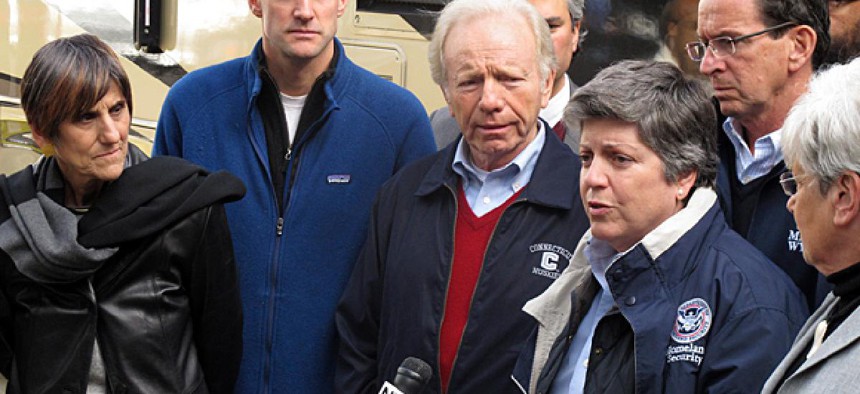DHS secretary issues waiver so ships can take fuel to disaster areas
Energy Department, EPA help reopen New York, New Jersey gas stations.
Homeland Security Secretary Janet Napolitano on Friday issued a blanket, temporary waiver of the 1920 Jones Act to allow foreign-flag ships to deliver fuel resources to energy-starved areas of New York and New Jersey still reeling from Superstorm Sandy.
The Federal Emergency Management Agency and the Red Cross, meanwhile, have stepped up cooperative efforts to restore power and deliver food, water and housing assistance -- with help from the Energy and Defense departments and the Environmental Protection Agency.
Thousands in the Mid-Atlantic region are currently unable to purchase gasoline either because service stations have run out of product or they lack electrical power for the gas pumps. Waiver of the Jones Act will allow additional oil tankers coming from the Gulf of Mexico to enter Northeastern ports to provide oil and refined fuel until Nov. 13.
“The administration's highest priority is ensuring the health and safety of those impacted by Hurricane Sandy, and this waiver will remove a potential obstacle to bringing additional fuel to the storm damaged region,” Napolitano said.
Also accelerating the rescue effort, said FEMA Administrator Craig Fugate in a Friday morning conference call with reporters, is work by Energy and Defense Logistics Agency employees to reopen local pipelines and increase refinery capacities. EPA contributed by temporarily waiving Clean Air Act requirements -- which vary by jurisdiction -- to give refineries greater flexibility to surge production of gasoline and diesel fuel.
FEMA’s other focus, according to Fugate, is getting storm victims to register with the agency through a toll-free telephone number or the website. With many in the area lacking power or cellphone service, teams of federal, state and local outreach personnel are visiting neighborhoods where much property was destroyed. “It’s easy for people who can see the news, who have working cable or a cellphone to call,” he said. “But for others, the information is only as far as you can walk and as far as you can see.”
As of 11 a.m. Friday, FEMA had registered 85,072 people from the areas declared as disaster zones and had disbursed $18,815,347 for rental assistance, some by direct deposit, others by check, Fugate said. Benefits may go on for as long as 18 months, with a cap of slightly more than $30,000, after which loans might be available from the Small Business Administration and the Housing and Urban Development Department.
Once communities are stabilized, FEMA and state and local authorities will assess other damage and destroyed federal facilities, he said. The widespread lack of flood insurance coverage -- for both residential structures and contents of the homes -- was a key reason President Obama opted for an early disaster declaration, according to Fugate.
The urgent needs for daily survival are being met by the Red Cross, said the nonprofit’s Senior Vice President of Disaster Services Charley Shimanski on the same conference call. Planning before the storm hit has allowed his volunteers to erect 40 shelters in New York City and Long Island and in eight other states that have housed 7,000, and to set up fixed and mobile feeding sites that have served more than 500,000 ready-to-eat meals. They have aided more than 5,000 people with medical and mental health issues. More than 80 emergency response vehicles and 4,000 disaster workers have come in from across the United States, with more en route, he said.
“It’s a very big job and we’ll be at it for week,” Shimanski said. “I know it’s a frustrating time for those affected, but we want them to know we’re doing everything possible.”
His team had seen TV news reports that Staten Island Borough President James Molinaro was angry that aid to his constituents appeared to be coming later than that for more-affluent areas. “We’ve been in direct touch with him to say we were facing the same circumstances as everyone else in terms of road access,” Shimanski said. But now that feeding operations are on the island, the borough leader has expressed his gratitude.




